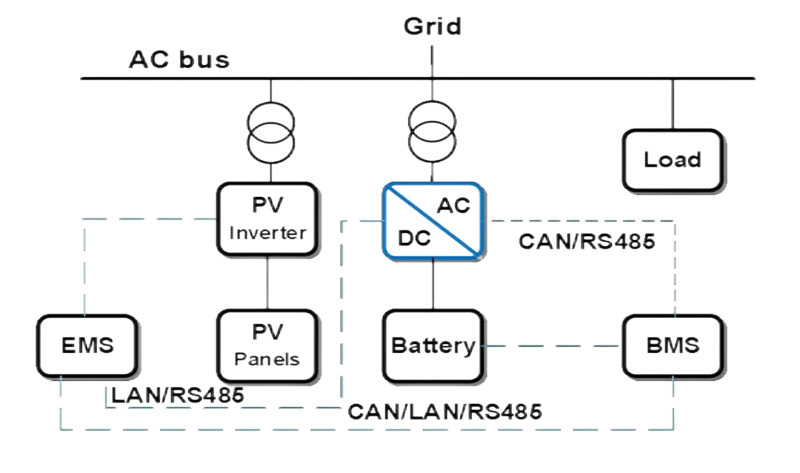Photovoltaic + Energy Storage + Grid
AC coupled with PV or other power sources together with the grid, mainly for maximization of self-generation and zero-consumption from the grid.
System Operation Logic:
Photovoltaic (PV) Working Principle
When PV power is sufficient sunshine, the photovoltaic inverter converts solar energy into direct current, which is then converted into alternating current through AC coupling to supply the load.
When demand is low, if the photovoltaic power generation exceeds the immediate load demand, the excess power can be stored in the battery or fed back to the grid.
Energy Generation and Transmission: Photovoltaic panels generate direct current (DC) electricity under illumination. The DC electricity is then converted into alternating current (AC) by an inverter and transmitted to the power grid. When there is ample sunlight, the PV generation capacity exceeds the load demand, and the excess electricity is transmitted to the power grid.
Participation in Peak Shaving and Valley Filling: During periods of low power system load (valleys), if the PV generation capacity is greater than the real-time electrical load, the excess electricity can be stored in the energy storage system to achieve "valley filling". During periods of high load (peaks), if the energy storage system has sufficient electricity and the PV station cannot meet the peak load demand alone, the energy storage system can release electricity. This, in conjunction with the PV station, supplies electricity to the grid, thus achieving "peak shaving".
Battery Working Principle
The battery energy storage system is a key link in achieving peak shaving and valley filling. It can store and release electricity in different time periods to smooth the grid load.
The battery energy storage system can be charged during periods of low electricity prices to store the electricity, and discharged during periods of peak electricity prices to provide electricity support to users or the power grid.
Charging mode: When demand is low, when the electricity price is low and the grid supply is sufficient, the battery is charged from the grid or distributed power sources.
Discharge mode: When demand is high, the battery discharges to the grid or directly to the load to reduce the burden on the grid and help balance supply and demand.
Charging Process (Valley Filling): During periods of low power system load, the excess electricity from the grid charges the battery through the battery management system (BMS). The BMS controls the charging equipment to charge the battery at an appropriate voltage and current, converting electrical energy into chemical energy for storage, thereby achieving "valley filling".
Discharging Process (Peak Shaving): When the grid requires peak shaving, the BMS receives a discharge signal and controls the battery to release the stored chemical energy back into the grid as electrical energy. This helps meet the high demand during peak periods, achieving "peak shaving". During discharging, the internal chemical reactions of the battery reverse, and the output current and voltage are regulated to meet the requirements of the grid.
Grid Working Principle
For the power grid, charging during off-peak hours and discharging during peak hours can reduce load fluctuations.
Monitoring and Signal Transmission: The grid is equipped with various monitoring devices such as smart meters and sensors, which continuously collect real-time operational data on grid voltage, current, and power. This data is transmitted to the grid's monitoring center or energy management system. When the system detects that the grid load is in a trough, it sends a charging signal to the battery end; conversely, when the grid load approaches or enters a peak state, it sends a discharging signal to the battery end.
Coordination and Optimization: Acting as the command center of the entire peak shaving and valley filling system, the grid end coordinates and optimizes the operation of all components based on the collected grid-wide operational data and the status information of each battery end, as well as other generating equipment like PV stations. For example, in scenarios with multiple battery ends, the grid end reasonably distributes the charging and discharging tasks for each battery based on their state of charge, charging and discharging efficiency, etc. This ensures the achievement of grid-wide peak shaving and valley filling goals while maintaining stable grid operation
Enclosure:







